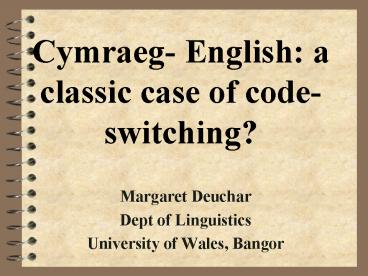Cymraeg English: a classic case of codeswitching PowerPoint PPT Presentation
1 / 21
Title: Cymraeg English: a classic case of codeswitching
1
Cymraeg- English a classic case of
code-switching?
- Margaret Deuchar
- Dept of Linguistics
- University of Wales, Bangor
2
Acknowledgments
- AHRB
- Bob Hollyman-Mawson
- Sioned Jones
- Tanya Moss
- Martin Sanderson
- Mari-Eluned Williams
- UWB
3
Data examples
- (1) tin gwybod lle maer youth hostel na?
- (2) dw in support-io Cymru
- (3) oedd on hollol ridiculous yn doedd
- (4) ond mae on standing joke
- (5) mae honna wedi mynd off am babi..
- (6) oedd on awful
- (7) oedden nhw mor desperate though
- (8) dw in love-io soaps
- (9) oedd on gar tua seven seater
4
Code-switching
- Intra-sentential
- the use of two languages in the same clause
(Myers-Scotton 20023) - (6) Oedd on awful
- Inter-sentential
- changing languages betweeen clauses
- (5) Mae honna wedi mynd off am babi,
- come to think of it.
5
Code-switching
- Intra-sentential
- the use of two languages in the same clause
(Myers-Scotton 20023) - (6) Oedd on awful
- Inter-sentential
- changing languages betweeen clauses
- (5) Mae honna wedi mynd off am babi,
- come to think of it.
6
Single word insertions switch vs. loan?
- Switch examples
- news
- support-io
- awful
- Loan examples
- cwpwrdd
- ffitio
- neis
7
What is classic code-switching?
- Unequal participation of two languages in a
clause - One main or matrix language in each clause
- Matrix language can be unambiguously identified
in each clause - Occurs in situations of stable bilingualism
- Speakers have a high degree of competence in the
matrix language.
8
Is Welsh-English a classic case of code-switching?
- Can a matrix language be identified
unambiguously as Welsh or English in each
bilingual clause?
9
Matrix Language Frame model
- Matrix Language Principle
- There is always an analyzable or resolvable
- frame structuring the morphosyntax of any CP
- (Myers-Scotton 20028).
- Asymmetry Principle
- Bilingual speech is characterized by asymmetry
- in terms of the participation of the languages
concerned (Myers-Scotton 20028). - Morpheme-sorting Principle
10
Morpheme-sorting principle
- All morphemes are not equal (Myers-Scotton
20029) - (1) content morphemes peth, thing
- (2) early system morphemes (peth)au,(thing)s
- (3) bridge late system morphemes
- (friend) of (John) , (llawer) o (bobl)
- (4) outsider late morphemes, e.g. subject-verb
agreement (she run)s, mae (hin rhedeg)
11
Identification of matrix language in each
bilingual clause.
- Criteria
- (1) Source of late outsider morphemes
- (2) Morpheme order
12
Application of criteria
- Example (10)
- mae on reit camouflaged
- be.3S.PRES PRON.3S-PRT quite
camouflaged - hes quite camouflaged
- is on reit camouflaged
- on mae reit camouflaged
- Criterion 1 Welsh
- Criterion 2 Welsh
- Matrix language Welsh
13
Application of criteria
- Example (11)
- beauty is in the eye of the beholder, ngwasi.
(dear) - Beauty is in the eye of the beholder, dear.
- beauty mae in the eye of the beholder, ngwasi
- is beauty in the eye of the beholder, ngwasi
- Criterion 1 English
- Criterion 2 English
- Matrix language English
14
An ambiguous result
- Example (12)
- o tin gorgeous
- oh PRON.3S-PRT gorgeous
- Oh youre gorgeous
- Criterion 1 not applicable
- Criterion 2 compatible with both Welsh and
English - Matrix language ambiguous
15
A problematic result
- Example (13)
- ddaru ni gyfweld pnawn ma am
- did we interview afternoon
this for - ddeg awr assistant i DS
- ten hour assistant to DS
- we interviewed this afternoon for a ten hour
assistant to DS - Criterion 1 not applicable
- Criterion 2 conflicting result
16
Quantitative analysis
- In what proportion of bilingual clauses is
- a Matrix Language unambiguously
- identifiable?
- 40 minute conversation
- 179 bilingual clauses
- 533 turns
17
ResultsMatrix language identification
18
Matrix language identification
19
Convergence in clauses with ambiguous matrix
language?
- O tin gorgeous
- oh PRON.3S-PRT gorgeous
- Oh youre gorgeous
- cf.
- O wyt tin gorgeous
- oh be.2S.PRES PRON.3S-PRT gorgeous
- Oh youre gorgeous
20
Convergence in clauses with ambiguous matrix
language?
- E.g. you know
- gwyddost
- be.2S.PRES
- wyt tin gwybod
- be.2S.PRES PRON.2S.PRT know
- tin gwybod
- PRON.2S.PRT know
21
Convergence in clauses with unidentifiable matrix
language?
- Example (13)
- ddaru ni gyfweld pnawn ma am
- did we interview afternoon
this for - ddeg awr assistant i DS
- ten hour assistant to DS
- ten hour assistant
- assistant deg awr
- we interviewed for a deg awr assistant
22
Convergence in clauses with unidentifiable matrix
language?
- Example (14)
- fi di bod i-r bus lle
- PRON.1S PRT be.NONFIN to-DET bus
place - Ive been to the bus place
- bus place
- lle bws/bus
23
Conclusions
- Welsh-English is a classic case of code-switching
- There is some small indication of convergence in
spoken Welsh structure towards English.

